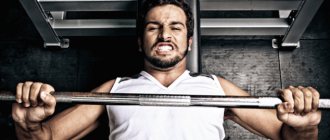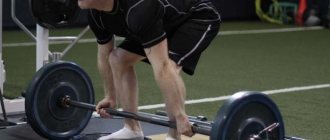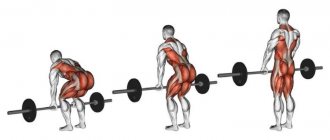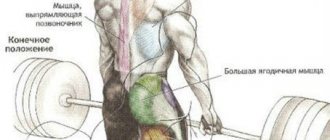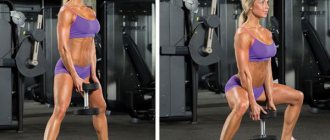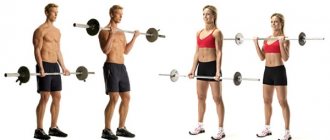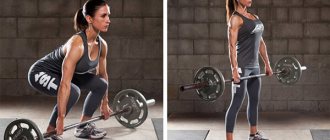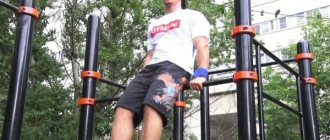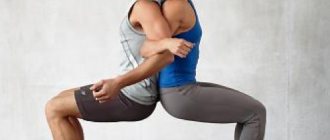Share:
What you need
- Barbell
- Platform
Sumo Deadlift is a basic strength exercise that involves lifting a barbell from the floor with legs wide apart to waist level. The sumo deadlift has become widespread in powerlifting, crossfit and other strength sports, as it allows you to fully unleash the athlete’s strength potential and achieve impressive strength records. Today we will tell you about the correct technique for performing a sumo deadlift, how this type of deadlift differs from others, and how to progress in it.
In our article today we will look at:
- What are the ways to perform deadlifts?
- Technique for performing the exercise;
- Newbie mistakes;
- How to increase strength in the sumo deadlift;
- CrossFit complexes containing this exercise.
Deadlift in the Sumo technique, features of execution and differences from the classical one
The deadlift is deservedly considered one of the most important basic exercises for bodybuilders. This is a complex exercise that involves many muscle groups and joints. Deadlifts maximize muscle growth by stimulating the production of natural anabolic hormones.
When performing the exercise, the largest muscle areas actively work: the athlete’s legs and back. For bodybuilding beginners, the classic deadlift can be replaced with the sumo version. This will help develop your back muscles not only effectively, but also safely.
Sumo or classic: which is the best way to perform deadlifts?
Both types of deadlifts are basic exercises and, in the absence of contraindications, will have a positive effect on the effectiveness of the training process. In both versions, traction involves a large number of muscle groups and has a complex developmental effect on the entire body.
Which technique to prefer will be determined by the athlete’s anatomical features and individual physical capabilities. Classic is more suitable for those with a short body, as well as those who do not have a sufficient level of flexibility. Tall athletes should master sumo style techniques.
bbb
If you have back problems, the classic deadlift can be traumatic; in this case, it is recommended to replace it with a sumo deadlift, which transfers a significant part of the load to the legs.
Below are the distinctive features of the two techniques in a tabular version. After studying them, you can determine the most preferable way to perform this exercise.
| Classic deadlift | Sumo deadlift |
| Feet are parallel | The feet are turned at an angle of 45o |
| Legs are located at shoulder level | Feet wider than shoulder-width apart |
| Hands go to the sides of the legs | Hands down between legs |
| The bar is taken with a shoulder-width grip | Grip width at shoulder level or narrower |
| The bar quickly comes off the floor and slowly rises | The lift-off occurs slowly, and on the rise the speed increases |
| The back bears the main load | Works mainly the legs and buttocks |
| During execution there should be a feeling of the floor pushing away from you | When lifting the barbell, you need to imagine that you need to push the floor with your feet |
If the deadlift is performed using the sumo technique, the distance that the projectile travels before completing the lift is reduced by 19% compared to the classic technique.
Both options involve a mental component: during active movement, you should focus on internal sensations. This is an important aspect of the effectiveness of such exercises. You need to concentrate not on the weight being lifted, but on the work of the muscles.
For the harmonious development of the body, a variety of training is required, so it is worth making changes to the program from time to time, performing deadlifts in different techniques.
Tips and tricks
A few words about the mistakes common to beginners, as well as about the nuances that will help in performing the exercise.
We recommend reading about how to do Romanian barbell deadlifts.
Common mistakes
A few words about the most common mistakes:
- To perform deadlifts, you need the right shoes. It should have a thin sole and provide rigid traction to the surface. Even the minimal reduction in amplitude that a thin sole provides can bring some bonuses. Wrestling shoes are an excellent solution, but barbells are more suitable for other barbell exercises.
- Large distance from the projectile to the feet. This circumstance makes it difficult to control and coordinate the body. Due to the large length of the lever, the barbell will outweigh you.
- Weightlifter's belt and straps. It is better to avoid using these pieces of equipment. They can indeed provide an advantage of several kilograms, but this advantage will be obtained at the expense of technique.
- Do not try to spread your legs too far, this can lead to spraining. Position your feet so that you can stand on them confidently and perform the exercise.
- The back should never be rounded. The back should always be straight, with a slight arch in the lower back.
Nuances and tricks for implementation
There are ways to increase the efficiency of this traction:
- Do not try to sit down deeply before performing the exercise; it will make it more difficult for you to perform deadlifts. In addition, in such a situation the quadriceps are more involved, and you are now working on other groups.
- Constantly monitor your movements. To do this, it is better for a beginner to practice in front of a mirror. Take a break between repetitions so that your technique does not suffer from the pace you take. Remember: technique is more important than weight and reps.
- Most back exercises work the legs, and vice versa. Therefore, space out the training of these groups in order to avoid excessive stress. For example: train your back on Tuesday and train your legs on Saturday.
- If you're just starting to introduce sumo deadlifts into your training program, try starting with 90% of your maximum lifting weight. It will be enough to perform 4-6 repetitions of the exercise.
The sumo deadlift is a great exercise for training your lower torso muscles. Working almost the same areas as the classic version of the exercise, only with a slightly different emphasis, it can become both your main type of deadlift and a complement to the classics.
This exercise can also be a solution to the problem for those who do not do the classics due to pain in the lower spine.
Training Tips
A coach will help you achieve good results in sports. He can promptly point out possible errors and correct them in a timely manner.
Warm-up
The warm-up begins with an empty bar to warm up the muscles. After completing 10-15 repetitions, you can put on plates, gradually increasing the weight. Number of approaches: 3-4 times, 6-8 repetitions.
Equipment
To perform deadlifts, professionals use special equipment. Is it necessary for beginners? In the exercise, it is not the weight lifted that is important, but the correct execution of the complex. Using belts and a belt is not at all necessary if you do not strive to become a champion in the number of kilograms lifted. The equipment makes it easier to hold a lot of weight in your hands. But pay special attention to shoes. The best models have the thinnest soles. It does not absorb shock and it will be much easier to tear the bar off the floor due to the shortening of the amplitude.
Weight
The weight of the burden is added gradually. You should start with a small comfortable weight, increasing the load over time. Muscles must adapt, otherwise a sudden increase in load will lead to serious injuries, even if there is nothing to indicate future problems on the day of training.
Sets and reps
In different strength sports, the number of approaches and repetitions is calculated according to a specific program. Beginner athletes are limited to one workout per week, 3-4 sets with repetitions 6-8 times and a weight of 50% of the maximum.
More advanced athletes, when working for strength, perform from 3 to 6 approaches of 4-6 repetitions with 90% of the weight of the one-time maximum, and when working for mass - 4-5 approaches of 8-12 repetitions and a working weight of 60-65% of the one-time maximum maximum.
Nutrition and sports supplements
Proper nutrition is important in sports. It must be correct and balanced. A calorie deficit will not result in active muscle growth.
Sports nutrition today is becoming increasingly popular, both among professionals and beginners.
Particular attention should be paid to supplements, such as protein, gainers, protein shakes. They ensure optimal muscle growth with regular exercise in the gym.
How to increase your sumo deadlift
To lift more weight on the barbell when performing the sumo technique, you need to give the barbell a certain acceleration. To do this, it is worth training the explosive strength of the leg muscles using special exercises (squatting on a bench with a delay in the lower position, long jumps, jumping onto a box). At the same time we strengthen our back. The following complexes are suitable: slopes with a barbell or shrugs with dumbbells.
The right equipment
Before you begin the exercise, make sure you choose the right clothes and shoes. This important factor is often needlessly ignored.
- Shoes must be flat-soled and without heels. These can be special “barbells” or “wrestling shoes”. This will allow you to distribute the weight of the lifted barbell and the applied efforts as correctly as possible.
- A weightlifting belt should be used when working with a significant weight of the barbell. This will not only significantly reduce the risk of injury, but also activate the muscles of the anterior abdominal wall.
- Leg warmers if you're wearing shorts or skinny ankle-length pants will protect the skin on your legs. When moving upward, the bar of the bar must slide along the shin, and there is a risk of damaging it.
- Shorts or sweatpants should not get in the way. be too long, too loose, have bulky pockets or other decoration that could interfere with the movement of the barbell during the exercise.
If you want to effectively tone your backside, learn how to do squats for your butt.
Read all about the muscles that are involved in the pullover exercise and the correct technique for doing it in this material.
You will find effective exercises with a wheel for hard abs here: https://gromila.net/uprazhneniya/press/s-kolesom.html
How to do sumo deadlifts correctly
Sumo style techniques are used to lift heavy weights. The nuance of this method is that the athlete places his legs quite wide. The distance between the legs is about 1.5 shoulder widths, the toes can even touch the pancakes. This technique is used extremely rarely in bodybuilding, more often in powerlifting.
So, the athlete’s position is straight, in front of the bar. The toes are turned slightly outward, and the knee joint is also directed there. The lifter bends the joints (hip and knee), tilts, the back remains straight. Grasp the bar with your hands approximately shoulder width apart. The athlete straightens up smoothly, without jerking, and holds the barbell with his arms extended downwards at the level of the mid-thighs. The reverse movement is accompanied by bending the legs at the same joints.
Benefits of Wide Stance Sumo Deadlifts
Like all multi-joint exercises, sumo deadlifts provide the opportunity to simultaneously work a large number of muscle groups and build muscle mass. In addition, this technique gives the athlete a number of advantages.
- The legs do a lot of work in this exercise, so it is useful to include this type of deadlift in a lower body training program in combination with squats and leg presses.
- The exercise develops not only strength, but also flexibility.
- The peculiarity of positioning the legs allows you to work more muscles than in the “classic”. In combination with a shorter trajectory of the projectile, this makes it possible to work with large weights, which is important for competitive athletes.
- The reduced range of motion puts less stress on the spinal and knee joints.
- For tall people, it is more convenient to perform deadlifts in this way.
- The center of gravity during sumo deadlifting is lower, which makes the athlete’s position when performing movements more stable.
- Sumo style techniques can be used by people who have back pain - in situations where the “classic” is undesirable. This is due to the reduced load on the lower back due to active leg work. This type of traction is more preferable for gym enthusiasts who are engaged in sedentary work and therefore have a weakened back. In addition, it basically reduces the risk of spinal injury.
bbb
How many approaches to perform
To increase muscle mass, it is recommended to do 3 to 6 sets of 8–12 repetitions. You need to start with a minimum number of repetitions per set and light weights. This will allow the athlete to emotionally tune in to heavy weights and not be afraid to lift the barbell.
They train deadlifts with a break, the muscles should rest and recover. The optimal regimen is once every 10 days or two weeks. Breaks are filled with exercises to strengthen the arms, hips and squats.
Safe Deadlift Technique
An athlete must always remember the safety principles. It is easy to get injured if you lose your balance, drop the barbell, or jerk the lift. In all of these cases, problems with the knee, hip joints, ligaments, lower back muscles and spine are guaranteed. Moreover, the higher the weight, the stronger the injury can be. Records show that a weight of more than 400 kg is quite within the capabilities of a lifter. But, a minimal lack of coordination of movement and damage to the nerves of the back and muscle fibers cannot be avoided.
Athletes who have previously had back injuries or spinal injuries are better off not tempting fate. They are not allowed to do deadlifts. It is recommended to replace the exercise with other types of load. What helps you avoid injury?
Inventory check
The weights on the bar in the deadlift must be strictly fixed with plugs. The weight and size of the pancakes are made the same on both sides.
Body position control
To do a deadlift correctly, you need to build a pose. The athlete is guided by general instructions, but adapts the width of his legs and the type of girth to himself.
Correct grip
The barbell must be held straight and confidently. If an athlete thinks that the bar will fall out of his hands, it is better to use special wrist straps. You need to train your wrist muscles to get a powerful grip.
Basic ways to grip a barbell:
- straight classic grip;
- mixed grip, “different grip”;
- to the "castle".
A straight grip puts maximum load on the forearms and increases arm strength.
In sumo style it is recommended to use a “different grip”. It holds the bar tighter. Its disadvantage is that a torque arises around the axis of the spine and not all athletes can cope with this. The hands are placed quite wide in sumo.
The “lock” method is when the phalanx of the thumb is hidden under the other four. This “weightlifter” grip holds the bar securely, but is painful.
What to do if your wrists are weak? Train separately from deadlifting and use straps or gloves. Please note that lifting the barbell using belts is not allowed at powerlifting competitions. For better grip and anti-slip, you should always use sports magnesium.
Conclusion
What is a deadlift for a lifter? This is training number one. It is always included in a set of exercises and the execution and number of repetitions are gradually increased in complexity. For beginners, the classic deadlift is suitable. It allows you to feel the muscles well and build a pose. This is the base for moving on to other styles such as Romanian or sumo style.
What you need to know before deadlifting
Like the classic deadlift, the sumo deadlift requires some preparation. This technique is more finicky about your stretching than the traditional version of the exercise. Therefore, you should take care of good leg stretching in advance.
It is also necessary to immediately decide on the grip. The safest and correct option for training is for your hands to hold the bar on one side with your fists facing outward (away from you).
It is impossible not to notice that powerlifting often demonstrates different grips. But, please note that there you need to lift the barbell 1 time. And these are not just working weights, but maximum ones. It is unlikely that the wrists will be able to support such weight with a regular grip. That’s why athletes hold the barbell this way at competitions. However, a different grip contributes to an uneven load on the spine and its twisting under the influence of weight. This significantly increases the risk of back injuries. Therefore, for training it is better to use a grip with your palms facing you.
Pay attention to the shoes too. Do not wear sneakers with soft spring soles. You need shoes with a flat, low and elastic platform. Because your heels should neither lift off the floor nor sink into it.
Stock up on an athletic belt. With a healthy back, serious weights should only be lifted with it. If you have a bad back, it is better to wear it even if you weigh 50 kg. This will protect you from possible complications.
Some trainers say that you don’t need to wear anything - let your muscles get used to the load. And when a person gets injured, they cite incorrect technique and haste in progressing the weights. Therefore, wear a belt even with light weights if your back sometimes experiences discomfort. Don’t be ashamed to warm up with an empty bar when others immediately lift 100 kg. Let others ruin their backs, but not you.
Classic deadlift
To perform this, your feet are not placed far apart, just slightly less than shoulder width apart. In this case, the posterior muscles of the thighs, the gluteus maximus and the erector spinae muscle are better tensed. This method is suitable for those who have a short waist and relatively long arms.
Performing deadlifts begins with lining up the posture and positioning the legs. The toes are placed parallel to each other or slightly turned outward. The projection of the shoulders, torso, and hips falls on the middle of the feet. The athlete takes a stable position. The shin is strictly perpendicular to the floor
It is important to make sure that there is nothing under your feet that interferes with the exercises. The shoulders are pulled back, the shoulder blades are moved towards each other, the body is kept straight
An athlete does a squat and takes a barbell from the floor. When the bar moves upward, the quadriceps is involved. The thigh itself should be at an angle of 45 degrees to the shin. There is no need to move your body forward. For the correct movement, the athlete keeps his back straight and his arms extended as much as possible to grasp the bar. The gaze is directed forward and upward. The bar moves strictly vertically along the upper body.
Sumo deadlift technique
The deadlift is the most traumatic exercise among bodybuilding exercises. The heavier the weight being lifted, the greater the danger. Lumbago, spondylolisthesis, disc displacement, spinal hernia - a minimal list of possible consequences. Failure to follow the correct technique can result in an accident or recall old, previously occurring injuries, so the deadlift must be approached with full responsibility.
Mastering the correct technique is quite difficult, so beginners should not try to lift heavy weights. Pioneers are recommended to exercise their body for 2-3 weeks and hone their skills with the help of squats and torso bends.
You can succeed in performing sumo deadlifts not only with strength, but also with a combination of it and flexibility. The exercise requires the athlete to be quite flexible. Particularly important is good mobility in the hip joints (the width of the legs depends on them), the biceps of the thigh, the Achilles tendon, the adductor muscles of the thigh and buttocks. Before you begin the exercise, you need to do a little stretching and warm up your joints.
Now for a step by step guide on how to do a sumo deadlift:
Widely spaced feet with toes turned 45 degrees or even more (so that the knees look to the sides). The toes should practically touch the barbell plates.
Straighten your back and arch your lumbar spine to prevent rounding during the pull. Straighten your shoulders, stick your chest forward.
The projection of the center of gravity should be the heels, so it is advisable to wear weights when performing the sumo deadlift exercise.
Lower yourself into a half squat so that your hips are horizontal to the floor and your knees are in line with your ankles.
Take the barbell with a narrow grip (it won’t work any other way due to the placement of your legs). From the outside it may seem that you are leaning forward, since ideally your back bends well in the lower phase.
Raise your pelvis slightly and tense your arms - this will provide a rigid “frame” and the muscles being worked will effectively contract.
Take a deep breath and, holding your breath, stand with the barbell on straight legs with a straight torso by working the quadriceps and other muscles of the lower extremities. Keeping the bar as close to your body as possible reduces resistance and makes it easier to control and pull the bar.
Pull your shoulders back and exhale.
When doing a sumo deadlift, as with any other deadlift, your gaze should be directed strictly forward (neither up, nor down, not to the sides) throughout the entire set.
Returning the barbell down is slightly faster than raising it up.
Deadlifts can be performed for one or more repetitions depending on the weight used. If you plan to perform a certain number of repetitions, you do not need to bounce the barbell off the floor. The projectile must be completely placed on the floor, and then only begin to pull back.
At competitive tournaments, a different grip is used (one palm in supination, the other in pronation), it eliminates any possibility of turning the bar, which allows you to cope with large weight loads. During training, it is better not to overuse different grips, because they disrupt the symmetry of the arms and shoulders.
The sumo deadlift is suitable for those athletes who have poorly developed back muscles or problems with the lumbar region. Anatomical features of the physique, along with technique, influence which muscles will succeed in work. The lifting exercise is easier to perform for ectomorphs who have disproportionately long arms or are tall. They can place their center of gravity quite low and carry more weight.
The ideal starting position is determined through individual selection. The width of the legs should be chosen so that it is optimal for the desired results and does not cause discomfort during execution. The wider the position of the legs, the shorter the lifting path of the projectile and the smaller the amplitude of movement on the deltas.
Sumo-style deadlifts should be performed on the day of strength training, somewhere in the middle of the training process after performing hyperextensions. It is recommended to alternate deadlifts and squats within the same workout, since both exercises put a serious load on the legs and back.
Video on how to do sumo deadlifts correctly:
More information on the topic: https://tutknow.ru
What muscles work in the sumo deadlift?
The traditional deadlift is a classic and one of the best, if not the best, deadlift exercises out there. This is because it works almost every muscle group in the back of the body. Therefore, it should also not be sent to the bench in favor of another exercise. However, you can (and I think you should) add sumo deadlifts to your rowing exercises. Just like a regular one, it uses a large number of muscles in the back of the body.
The target muscle groups in this case are the hamstrings and gluteal muscles. You work this area (especially the tendons) more than with a regular deadlift due to the wide stance.
The abductor muscles are also well worked out. It also works the quadriceps, although this greatly depends on how wide you can spread your legs. And when deadlifting, your forearms also strain, but this is quite obvious, because although the legs do the main work, you still hold the weight with your hands.
As for the secondary muscles, almost the entire back is involved. Thanks to the retraction of the shoulder blades, which you perform at the top of the row, your trapezius receives its portion of the load. Additional stabilizing muscles for this particular deadlift include the hip flexors, abs, and rhomboids.
Let us next consider all the stages of performing a sumo deadlift
Initial position.
At this point, especially noteworthy is the placement of the legs and the turn of the feet. It is logically clear that the wider your feet are, the shorter the distance the barbell will travel and, therefore, you will be able to lift more weight. However, you should avoid extreme leg widths, in which your feet will begin to move apart at the moment the bar lifts off, and you may get injured. When you are just starting to train sumo deadlifts, you should not immediately place your feet wide. You need to arrive at the optimal width of your feet after a series of training sessions, when you yourself understand how to stand up so that you are comfortable. If you do not have enough flexibility to set your legs wide, then you should include stretching and flexibility exercises in your training. Your feet should be turned at an angle of 40-60 degrees. The spread here is so large because by slightly changing the angle of your feet, you can notice an increase in the result, so this indicator is very individual, but you should strive to ensure that the bent knee and foot are facing in the same direction. The position of the barbell relative to the legs should be such that so that in the lower position of the body the shins lightly touch the bar.
Grip of the bar.
Hands should pass between your knees. The grip should not be too narrow or too wide, otherwise it will be difficult for you to maintain balance. Grip width is also worth experimenting with light weights on the bar to find the best placement. The optimal grip for the bar in terms of load distribution is a straight grip, with both palms facing you. However, for many athletes, this grip does not allow them to lift maximum weight. In this case, it is better to use a different grip, when one palm is directed towards you and the other away from you. In this case, it is necessary to periodically change the position of the palms to the opposite one to redistribute the load of axial rotation that occurs due to different grips.
Bar lift and deadlift.
Athletes whose legs are stronger than their backs should squat as low as possible during the start and keep their back as straight as possible. In this case, the main burden will naturally fall on the legs. Immediately after lifting off the bar, it must be quickly accelerated to pass the dead center normally. When pulling with your back, the squat position is not so low and the body is more inclined forward. In this case, the lifting of the bar and its further lifting is done more smoothly than when pulling with your back.
Return the bar to its original position.
It is carried out somewhat faster than the rise. When performing sumo deadlifts, it will also be easier for you to lower the barbell, since this process is not interfered with by your knees, as in the classic style.
It will also be useful to read articles on deadlift technique, correct deadlift. If you are just starting out in powerlifting and are learning the techniques of various exercises, we also recommend reading the articles squat technique and bench press technique.
You can see a frame-by-frame reproduction of the sumo deadlift technique below:
Did you like the material? Share the link with others!
Do you want to be the first to know about site updates?
Tags:
What kind of exercise is this
The deadlift is one of the best exercises for gaining overall muscle mass. Beginners to the sport unreasonably consider its implementation too dangerous and difficult, so the priority is complexes for the chest and biceps muscles. In part, these fears are true. Doing the exercise incorrectly can lead to dangerous back injuries.
The sumo deadlift is aimed at creating strong muscles in the legs and back, without which it is impossible to fully pump up the body. The exercise is included in the basic training complex for bodybuilders. The technique involves lifting the barbell from the floor with legs wide apart to waist level and returning the barbell to its original position.
The complex, in addition to bodybuilding, is used in functional circuit training (trap bar deadlifts), powerlifting and other strength sports. Deadlift contributes to the maximum strength load of athletes and unlocks their potential before great strength records.
Sumo deadlift technique
Sumo deadlift technique
The deadlift is the most traumatic exercise among bodybuilding exercises. The heavier the weight being lifted, the greater the danger. Lumbago, spondylolisthesis, disc displacement, spinal hernia - a minimal list of possible consequences. Failure to follow the correct technique can result in an accident or recall old, previously occurring injuries, so the deadlift must be approached with full responsibility.
Mastering the correct technique is quite difficult, so beginners should not try to lift heavy weights. Pioneers are recommended to exercise their body for 2-3 weeks and hone their skills with the help of squats and torso bends.
You can succeed in performing sumo deadlifts not only with strength, but also with a combination of it and flexibility. The exercise requires the athlete to be quite flexible. Particularly important is good mobility in the hip joints (the width of the legs depends on them), the biceps of the thigh, the Achilles tendon, the adductor muscles of the thigh and buttocks. Before you begin the exercise, you need to do a little stretching and warm up your joints.
Now for a step by step guide on how to do a sumo deadlift:
Widely spaced feet with toes turned 45 degrees or even more (so that the knees look to the sides). The toes should practically touch the barbell plates.
Straighten your back and arch your lumbar spine to prevent rounding during the pull. Straighten your shoulders, stick your chest forward.
The projection of the center of gravity should be the heels, so it is advisable to wear weights when performing the sumo deadlift exercise.
Lower yourself into a half squat so that your hips are horizontal to the floor and your knees are in line with your ankles.
Take the barbell with a narrow grip (it won’t work any other way due to the placement of your legs). From the outside it may seem that you are leaning forward, since ideally your back bends well in the lower phase.
Raise your pelvis slightly and tense your arms - this will provide a rigid “frame” and the muscles being worked will effectively contract.
Take a deep breath and, holding your breath, stand with the barbell on straight legs with a straight torso by working the quadriceps and other muscles of the lower extremities. Keeping the bar as close to your body as possible reduces resistance and makes it easier to control and pull the bar.
Pull your shoulders back and exhale.
When doing a sumo deadlift, as with any other deadlift, your gaze should be directed strictly forward (neither up, nor down, not to the sides) throughout the entire set.
Returning the barbell down is slightly faster than raising it up.
Deadlifts can be performed for one or more repetitions depending on the weight used. If you plan to perform a certain number of repetitions, you do not need to bounce the barbell off the floor. The projectile must be completely placed on the floor, and then only begin to pull back.
When adding weights to the sumo deadlift, sooner or later you will begin to have difficulty holding the barbell. In this case, hand straps will greatly simplify the work, but when using them, the grip strength will not be fully involved in the work.
At competitive tournaments, a different grip is used (one palm in supination, the other in pronation), it eliminates any possibility of turning the bar, which allows you to cope with large weight loads. During training, it is better not to overuse different grips, because they disrupt the symmetry of the arms and shoulders.
The sumo deadlift is suitable for those athletes who have poorly developed back muscles or problems with the lumbar region. Anatomical features of the physique, along with technique, influence which muscles will succeed in work. The lifting exercise is easier to perform for ectomorphs who have disproportionately long arms or are tall. They can place their center of gravity quite low and carry more weight.
The ideal starting position is determined through individual selection. The width of the legs should be chosen so that it is optimal for the desired results and does not cause discomfort during execution. The wider the position of the legs, the shorter the lifting path of the projectile and the smaller the amplitude of movement on the deltas.
Sumo-style deadlifts should be performed on the day of strength training, somewhere in the middle of the training process after performing hyperextensions. It is recommended to alternate deadlifts and squats within the same workout, since both exercises put a serious load on the legs and back.
Video on how to do sumo deadlifts correctly:
Important tips for performing the exercise
When mastering the sumo-style deadlift technique, you need to take into account several significant points:
- When starting to work in this version, you should not immediately move on to heavy weights, even if you have experience performing deadlifts in the classical way. The priority should be practicing the correct technique.
- To make it more convenient to hold the bar, many athletes use an overhand grip (a position in which the palms are turned in different directions). But this is only justified in competitions, when the weight usually only needs to be lifted once, and not in training. This position of the hands leads to an uneven load on the spinal column and increases the risk of injury. It would be preferable to take the projectile with your palms facing you and, if necessary, using the straps.
Using straps when performing the exercise
- This technique requires a rather narrow grip, which makes it difficult to control its position. To prevent the plates from sliding off the bar during training, they need to be secured with locks.
- When lifting, you need to keep your abdominal muscles tense: this will ensure that you maintain an optimal body position.
- To control the correct execution of movements, it is advisable to position yourself in front of a mirror.
All aspects of the sumo style deadlift can only be fully learned through practice. By experimenting with the width of the legs and grip, the weight of the projectile and the number of repetitions, you will soon be able to choose an option that will make the training effective. The main thing is to achieve the correct technique and not force the load to avoid injury.
Algorithm of actions and main difficulties
- Stand close to the barbell, your shin should almost touch the bar.
- Place your feet turned 45 degrees, wider than your shoulders, almost under the barbell plates.
- Lower yourself into a squat, keeping your back straight and your shins perpendicular to the floor, until you grab the bar with an overhand grip, keeping your arms parallel. Tighten the muscles of your back, abdomen, arms and legs.
- Using your legs and back, trying to press your heels into the floor without rounding your back, slowly, without jerking, lift the barbell, while straightening your legs and standing upright.
- Slowly lower the barbell back down, returning to the starting position. Don't drop the barbell or round your spine.
Since the sumo deadlift is a complex and difficult exercise, performing it incorrectly can result in injury or simply a significant decrease in efficiency.
To avoid this, you need to remember a few common mistakes and not repeat them.
The back should be straight, the muscle corset should be tense. This will develop and strengthen the back muscles without unpleasant consequences for the spine.
You need to lean on your heels. lift the weight not with your shoulders, arms or solely your lower back, but with the combined work of the muscles of your legs and back.
Watch the position of your shins: your knees should not hang over the bar or converge inward
You can adjust the load on your back by positioning your pelvis in the starting position. As you go lower, you transfer some of the effort to your legs.
The barbell does not need to be “bounced” off the floor or, conversely, to finish the repetition with the barbell suspended. The apparatus should slowly fall to the floor at the end of each repetition.
This will make the exercise most effective, since the main effort in the deadlift occurs when lifting the barbell from the floor.
Watch the sumo deadlift technique video to better understand how to prevent injuries and do everything correctly:
Subject to proper execution technique, the sumo deadlift has several important simplifications and advantages over the classic deadlift, while not falling behind it in terms of efficiency.
Therefore, this heavy compound exercise can be an important part of the training program for both the serious beginner and the trained athlete.
Common mistakes
Deadlift does not tolerate errors in execution technique. Minor errors and deviations from the ideal trajectory of movement either immediately lead to injury, or accumulate and affect health later.
Mistakes to avoid:
- Crooked back row. Too much weight and weak erector spinae muscles.
- A sharp lift of the barbell from the platform.
- The bar moves too far from the body line
- When the barbell is finally fixed, the lower back bends forward strongly.
- The knees go in or out from the line of the feet.
- The center of gravity moves from your heels to your toes
- With the feet set as wide as possible, the barbell falls on the toes as it lowers to the floor
How to increase your deadlift
There are several techniques for increasing the weight you can handle in a sumo deadlift. It is worth telling more about them.
To work with heavy weight, it is necessary to give the projectile the necessary acceleration, that is, a jerk. To develop a jerk, it is necessary to train such an element as the explosive power of the legs.
The following exercises are suitable here:
- jumping from a seat onto a cabinet;
- squats with a stop (4-6 sec.) at the bottom;
- standing long jump.
Now about the back muscles. As it becomes clear from the description of the technique, the longitudinal muscles of the back and trapezius are quite actively involved in the exercise.
Did you know? The absolute world record holder in the deadlift is Englishman Eddie Hall. On July 9, 2020, he set a record of 500 kg.
Traditional complexes for these groups are perfect for training:
- shrugs;
- hyperextension;
- tilting with a load;
- dumbbell row to the chin.
There is another approach to increasing the working weight: changing the lifting height of the apparatus - increasing (the barbell is on the floor, you are on a podium 8-12 cm high) or decreasing - you are on the floor, the apparatus is on the podium.
- In the first option (increased amplitude), the legs are loaded more, which allows them to train their explosive power. In this case, you should work with weights that are approximately 1/4 less than your normal working weight.
- When performing a shortened row, the back is more actively loaded. In this version of the exercise, you can take approximately 1/4 more weight than usual. This practice, in addition to direct physical activity, gives a good psychological effect - the athlete mentally prepares to work with weights greater than what he usually works with.
